History can be changed by simple moments, by sometimes surprisingly small events of the sort that happen every day. But when those events happen at just the time, in just the right place, the world can be forever altered.
It was one such event in Mexico that redirected a young woman’s life and gave the Western Hemisphere one of its most celebrated and iconic artists. This is the story of that moment – the bus accident that changed Frida Kahlo’s life forever.
Table of Contents
The Life of Frida Kahlo before the Accident
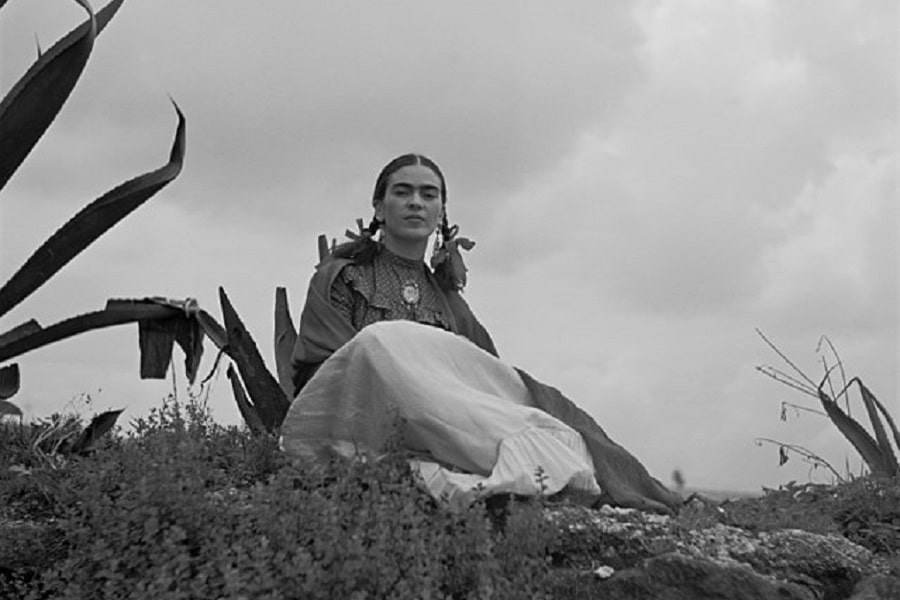
To fully understand the change in who Frida Kahlo became after the terrible Frida Kahlo accident, it’s necessary to first look at who Frida Kahlo had been. More to the point, it’s necessary to look at who she’d planned to be.
Frida Kahlo – or more formally, Magdalena Carmen Frida Kahlo y Calderón — was the third of four daughters born to Guillermo Kahlo, a German photographer who’d immigrated to Mexico, and his wife Matilde Calderón y González. She was born on July 6th, 1907, in the Coyocoan borough of Mexico City.
Childhood Suffering
While pain would certainly define her life and art later, she was actually introduced to it early on. Stricken with polio, Kahlo spent a great deal of time bedridden in her childhood home – the Blue House, or Casa Azul – as she recovered. The disease left her with a withered right leg which she would cover with long skirts throughout her life.
The disease also introduced her to love – or rather, a need – for art as a way to escape her limitations. When she was still housebound with polio, the young Frida Kahlo would breathe on the glass of the windows, tracing shapes with her finger in the fogged glass.
But though she would dabble in painting as she grew – and had worked as an engraving apprentice for a time – she’d given it no serious thought as a career. Her intended path, rather, was in medicine, and Kahlo attended the prestigious National Preparatory School – one of only thirty-five female students – in pursuit of that goal.
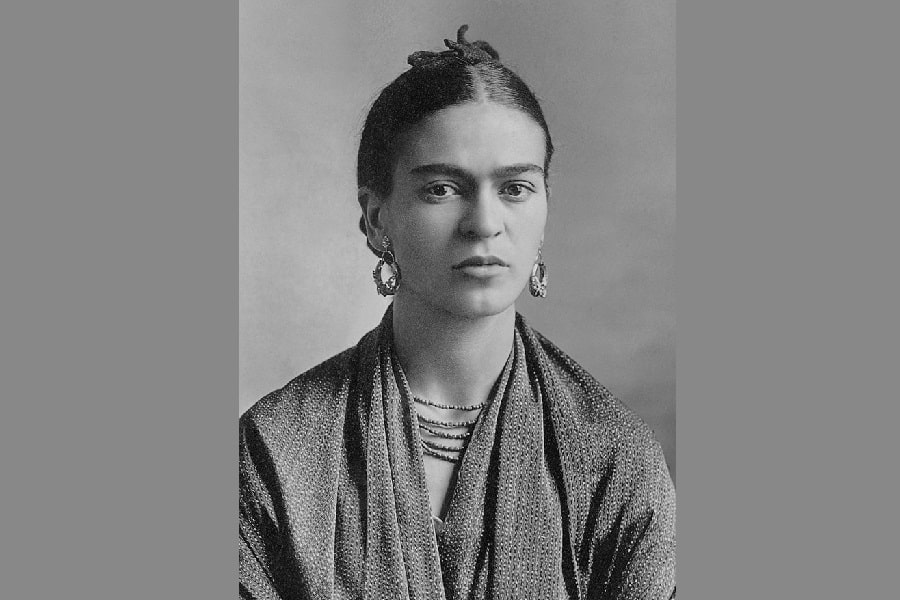
History Changed by a Missing Umbrella
History turned on September 17, 1925. After school, Kahlo and her then-boyfriend, Alejandro Gómez Arias, had meant to board the first available bus home to Coyocoan. But the day was gray, and a light rain had already fallen, and when Kahlo had trouble finding her umbrella the two were delayed and had to take a later bus instead.
This bus was colorfully painted and had two long wooden benches running down each side in lieu of the more conventional rows of seats. It was heavily crowded, but Kahlo and Gómez Arias managed to find space near the rear.
Navigating through the busy streets of Mexico City, the bus turned onto Calzada de Tlapan. An electric streetcar was approaching the intersection just as the bus reached it, but the bus driver tried to slip through before it got there. He failed.
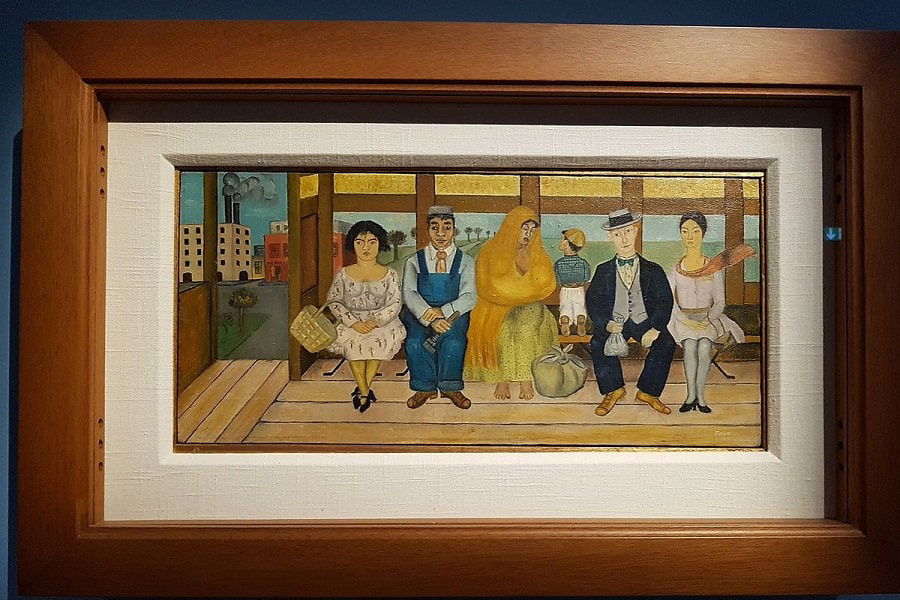
Frida Kahlo’s Bus Accident
The trolley rammed into the side of the bus as it attempted to speed through the intersection. It didn’t stop with the impact, but continued moving, the bus folding around the front of the trolley as it pushed forward.
In the book Frida Kahlo: An Open Life, Kahlo would describe the crash to author Raquel Tibol. “It was a strange crash, not violent but dull and slow,” she said, “and it injured everyone, me much more seriously.”
The bus bent to its breaking point, then split open in the middle, spilling unfortunate passengers into the path of the moving trolley. The front and rear ends of the bus were compressed – Gómez Arias recalled that his knees touched those of the person who had been sitting across from him.
While some in the center of the bus were killed – or would later die of their injuries – many of those on the ends were severely injured, including Kahlo. One of the bus’s handrails had come loose in the slow crash and impaled her through the abdomen.
The handrail had entered Kahlo at the left hip and exited through her genitals, fracturing her pelvis in three places as well as inflicting multiple fractures on her lumbar spine. In addition to the abdominal wound from the handrail, Frida Kahlo had suffered a broken collarbone, two broken ribs, a dislocated left shoulder, some eleven fractures in her right leg, and a crushed right foot.

The Aftermath of the Fridha Kahlo Accident
Somehow, Kahlo’s clothes had been torn away in the accident. In an even more surreal twist, a fellow passenger had been carrying powdered gold, and when the package burst in the crash Frida’s nude, bloody body was covered with it.
When her boyfriend pulled himself from the wreckage (miraculously with only minor injuries) he saw the extent of Frida’s injuries. Another passenger, seeing the handrail impaling her, immediately moved to extract it, and witnesses would later note that her scream drowned out the approaching sirens.
Gómez Arias carried Frida to a nearby storefront and covered her with his coat until help arrived. Then Kahlo, along with the other injured passengers, was transported to the Red Cross Hospital in Mexico City.
Given the state of her injuries, doctors were doubtful she would survive even the initial operations. She did – and several more after. Kahlo endured thirty different operations to repair her shattered body and was placed in a full-body plaster cast to begin the long process of letting her injuries repair themselves as much as they ever would.
The Convalescence
In time, Kahlo was deemed stable enough to convalesce at home, but this was only the beginning of her healing process. Her injuries meant she would be bedridden for months and would have to wear a body brace to hold her shattered body in alignment as she healed.
This meant Kahlo had a great deal of time, and nothing to occupy it. To help fill the empty days, her parents obliged her with a lap easel so she could resume the hobby that had sustained her through polio – art. Unable to leave her bed, she had only one reliable model – herself, so her parents installed a mirror in the bed’s canopy to facilitate her painting self-portraits.
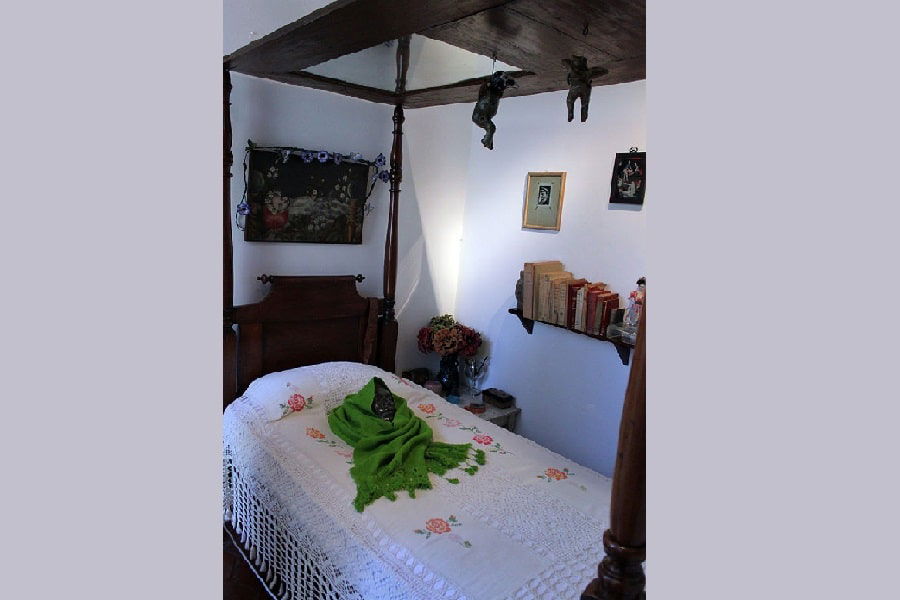
A New Direction
With this escape from the pain and tedium of her recovery, Kahlo rediscovered her love of art. At first – with her eyes still on a future in medicine – she began to entertain the idea of doing medical illustrations.
As the weeks went on and Kahlo began to explore her creativity, however, her initial ambitions regarding medicine began to fade. Art became as much of a mirror as the one above her bed, allowing her to explore her own mind and her own pain in a uniquely intimate way.
Frida Kahlo’s New Life
Kahlo’s recovery finally ended in late 1927, some two years after the bus accident. Finally, she could return to the outside world – though her world was now much changed.
She reconnected with her classmates, who had all now moved on to university without her. With her previous career plan in tatters, she became increasingly active in the Communist movement. And she became reacquainted with the famous muralist Diego Rivera, whom she’d met as a student when he’d done a mural on the school campus.
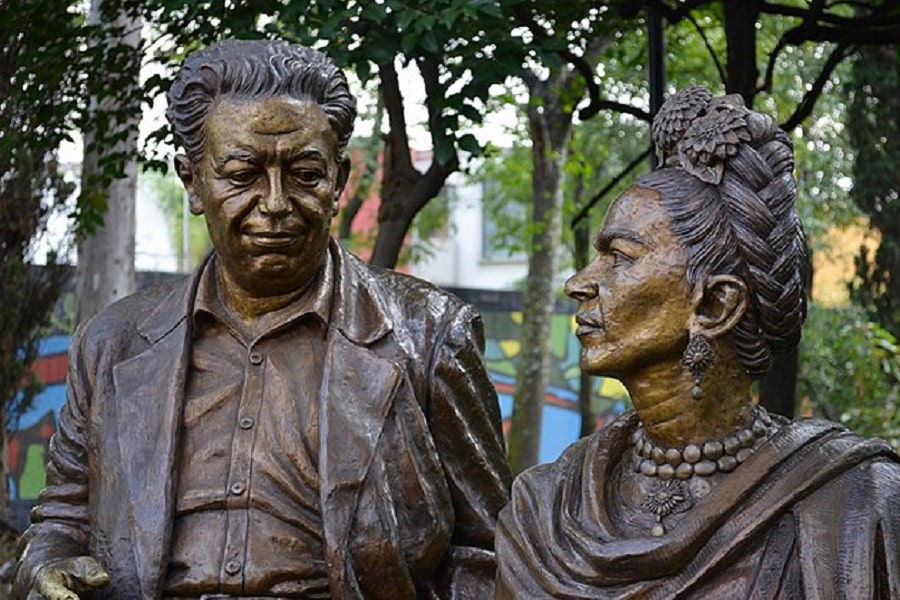
Her “Second Accident”
Rivera was more than 20 years her senior, and a notorious womanizer. Nonetheless, Kahlo retained a crush on him she’d developed as a student, and the two soon married.
The marriage was endlessly tumultuous, and both engaged in numerous affairs. Kahlo, proudly bisexual, had dalliances with both men and women (including Leon Trotsky and Georgia O’Keefe, as well as many of the same women as her husband). These were mostly taken in stride by the couple, though Rivera frequently became jealous of Kahlo’s male lovers, and Kahlo was devastated by the revelation that Rivera had actually carried on an affair with one of her sisters.
The two separated multiple times but always reconciled. They even divorced once but remarried a year later. Frida would come to refer to the marriage as her other accident, and the worst of the two she’d suffered.
International Exposure
But however volatile the marriage was, it inarguably brought Kahlo into a greater spotlight. Internationally acclaimed, Rivera brought his wife to America for three years while he worked on numerous commissioned murals, including one at Rockefeller Center in New York (though he would be fired from that one over his insistence on including Communist imagery).
READ MORE: Sifters: Native American Women’s Lives
Kahlo and her artwork were brought into the elite circles of the international art world. And Kahlo’s fierce confidence and signature style (she had by this time adopted her iconic traditional Mexican dress and prominent unibrow) garnered her attention in her own right.

Frida’s Legacy
Kahlo’s unflinching portrayals of personal suffering and overt sexuality, as well as her bold colors and Surrealist style (though Kahlo herself dismissed that label) have made her art some of the most readily recognizable in the modern era. Her art opened the door for women – through art and otherwise – to openly express their pain, fear, and trauma.
Several of Kahlo’s self-portraits offer stark, if stylized accounts of her own physical suffering, such as the painting Broken Column (which reflects her suffering from ongoing spinal surgeries to correct the lingering effects of the bus accident), or Henry Ford Hospital (which captured her anguish following her miscarriage). Many others reveal her emotional torment, often from her marriage to Rivera or her own insecurities or fears.
Though limited by declining health, she spent some time teaching at “La Esmeralda,” or the National School of Painting, Sculpture, and Printmaking in Mexico City. In her brief time teaching there – and later at home when she could no longer journey to the school – she inspired a crop of students referred to as “Los Fridos” for their devotion to her mentorship.
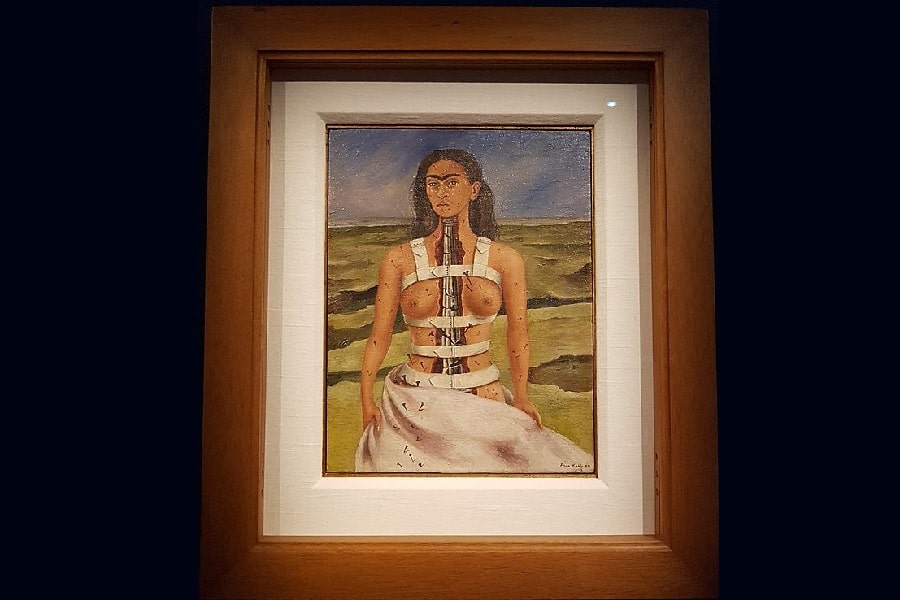
Posthumous Recognition
But in her own time, true popularity mostly eluded Kahlo and her artwork. It was only in her final years, and especially after her death in 1954 at the age of only 47, that her work began to enjoy true recognition.
But Kahlo’s influence extended beyond her art. She introduced Mexican dress and national culture to the mainstream during her visits to the US and Europe, and the Tehuana dress entered the consciousness of high fashion through her example.
And she herself remains a powerful influence – her unapologetic sexual imagery, personal bisexuality, and proud non-conformity made Frida an LGBTQ icon beginning in the 1970s. Likewise, her fierce, strong personality made her an icon for feminists of all stripes.
Today, her childhood home has become the Frida Kahlo Museum. In it, visitors can see Kahlo’s tools and personal possessions, family photos, and several of her paintings. Even Kahlo herself remains here; her ashes were kept in an urn on an altar in her former bedroom.
And all this because, on a rainy day in 1925, a young woman couldn’t find her umbrella and had to take a later bus. All of this because a bus driver made a poor choice at an intersection. The creation of one of the modern era’s most unique and famous artists and an icon of lasting influence, because of the kind of simple, small moments – the accidents – on which history can turn.